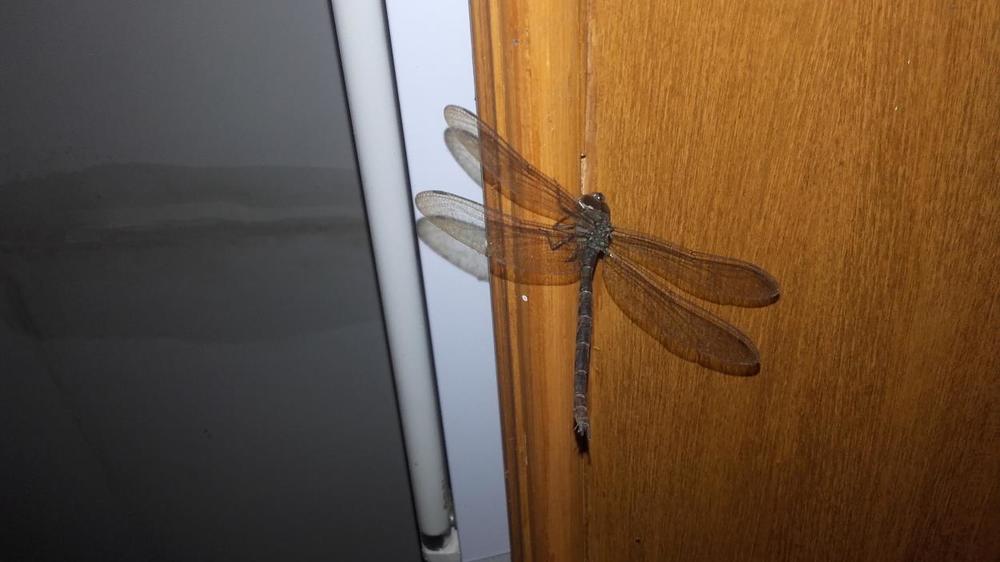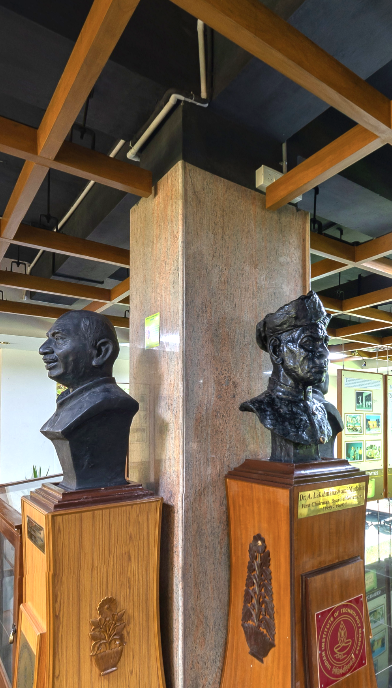
-
Gate Crashers
Nov 30, 2016
Kumaran Sathasivam
It is the season when we experience the shortest days of the year. It gets dark earlier in the evening, and by 5 the lights of the Heritage Centre, seen through the glass sides, are accentuated, drawing the attention of passers-by.
Some of the cyclists and people walking along near Administration Block are even induced to drop in. Often, they are students who did not know about the Heritage Centre although they have been on campus a number of years.

At the Heritage Centre, one evening in October 2016: The dragonfly Gynacantha dravida pays a visit.
The entrance of the Heritage Cenre is particularly well lit now. The pair of lights we have installed above Prof. Sengupto’s painting stand out, bright as they are, with the life-size portrait being located close to the door. Further, we have not yet removed the fluorescent lamps that had been fitted originally to illuminate the first Director’s likeness.
The painting is a faithful re-creation of another painting that was made in the 1960s. The old painting was damaged in recent years due to damp and termites.
We assigned the firm of Cherian Brothers the task of making the new oil painting. We provided them the old, damaged painting as well as a number of photographs of Prof. Sengupto. The new portrait was officially unveiled at the Heritage Centre Day celebrations on 3 March 2015.
This year, one day in October, we discovered that the woodwork in the Heritage Centre was infested with termites. The wooden shelves in which we stored our books, files and
photographic collections were badly affected. Much worse, the termites were actually turning their attention to our valuable albums. Fortunately, only a couple of albums had been damaged when we discovered this attack.
We took emergency measures to avoid further damage. We evacuated all the albums to the little theatre at the rear of the workshop. The wooden shelves were dismantled. Most of them were so badly eaten up that they had to be discarded. The albums were treated to a fumigation-like treatment to eliminate any lurking termites. The couple of albums that were damaged were sent for restoration. We consulted Mr. Jadhav, Librarian, and ordered new metal shelves with glass fronts to store the albums in. Once we get these, we will be using naphthalene balls and organic repellents freely. We will also be inspecting the albums very regularly. We plan to install dehumidifiers and air conditioners in our storage facility. These will run 24 × 7.
Having dealt with the protection of the photographic collections, we turned our attention to the portrait of Prof. Sengupto. Since the older painting had been attacked by pests at the same location previously, the painting was removed from the frame and termite treatment carried out on the wall behind it. The wooden frame was treated with varnish. There is a wooden board behind the painting. This was painted afresh. A coat of linseed oil was applied on the painting itself.
The temporary removal of the painting was treated as an opportunity to install new lights.
When all this work was going on, the glass doors at the entrance were kept open to permit the various teams of workers to move in and out freely. And as I said, in the evenings, the lights above the painting blazed into the dark. One day, carpenters were removing the remains of the old shelves. Drawn, no doubt, by the lights, a swarm of mosquitoes came in just as the workers were leaving, as though they were the night shift at the Heritage Centre.
Another evening, it was a predator of mosquitoes that wandered in through the entrance. This was a specimen of Zyxomma petiolatum, a species that is known for being active in the dusk, consuming the smaller insects that awaken then. Zyxomma petiolatum has an extraordinarily slender body. A third evening, a different kind of dragonfly was drawn into the Heritage Centre by the lights. This was a specimen of the large species Gynacantha bayadera. This too is a crepuscular species, pursuing its prey in the gloaming. All dragonflies, with their enormous compound eyes, have acute vision. But these predators of the dark must have particularly good powers of vision. They were transfixed by the lamps above the painting, and they appeared to be fastened to them like so many fridge magnets.
These are not the first occasions that animals of our campus have visited the Heritage Centre.
Some years back, a spotted deer chose to enter the Heritage Centre by unorthodox means. It was night, and the Heritage Centre was locked. The deer crashed in through the glass. It also did not wait for the doors to be opened to make its egress. It just crashed out again through the glass into the dark. Apparently it was quite unhurt.
Why did the deer come in and leave as it did? No one has any idea. As they say, nothing was missing.
Your response to Letter from Heritage Centre is welcome. Please send mail to heritage@iitm.ac.in
The Heritage Centre is located in the ground floor of the Administration Building, IIT Madras. It is open on weekdays from 9.30 am to 5.30 pm.
- Contribute
to the Centre -
Monetary
Support - Digital
Material









